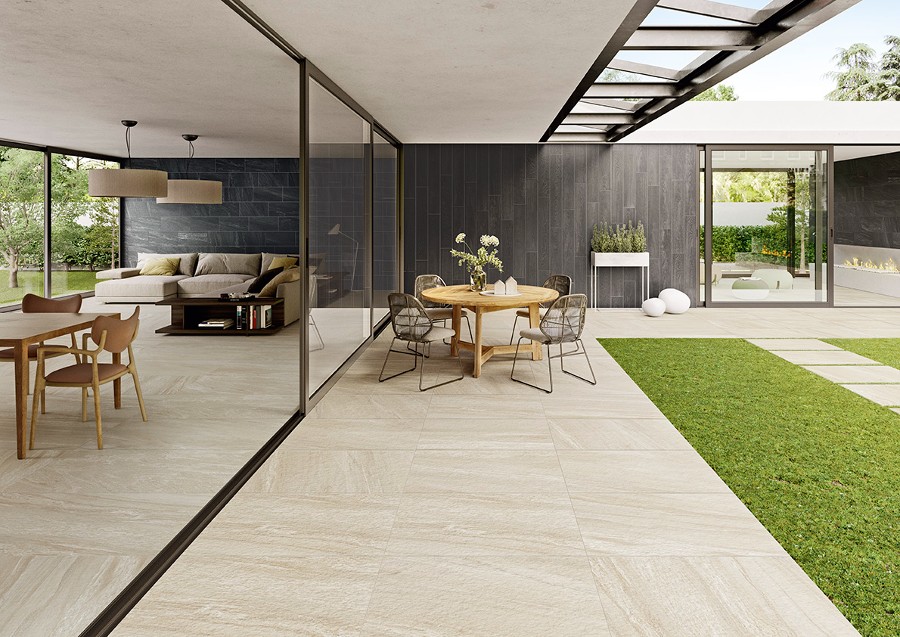When it comes to home design, the lines between indoor and outdoor spaces are becoming increasingly blurred. A great way to create a cohesive and fluid connection between your interior and exterior areas is through mixing tiles that complement both spaces. Choosing the right combination of interior and exterior tiles not only enhances your home’s aesthetic appeal but also adds functionality and continuity throughout the design. In this article, we’ll explore how to effectively mix tiles for a seamless indoor-outdoor look, with practical design tips to inspire your next project.
1. Create a Visual Flow Between Indoor and Outdoor Spaces
One of the key principles in mixing interior and exterior tiles is to create a visual flow that connects both areas. This helps your home feel more open, cohesive, and inviting, particularly in spaces like patios, terraces, or open-plan areas where the boundary between indoors and outdoors is fluid.
To achieve this, opt for tiles in similar or complementary colors, textures, and patterns. For example, if you have natural stone tiles on your outdoor patio, consider using the same or similar stone indoors in areas such as entryways, kitchens, or living rooms. The continuity of materials will blend the two spaces seamlessly.
Tip: Use a neutral color palette to ensure that the tiles create a smooth transition. Colors like beige, gray, or light brown work well both indoors and outdoors and make the space feel larger and more connected.
2. Blend Different Textures for Contrast
While continuity is important, adding variety through texture is equally essential when mixing interior and exterior tiles. Indoor tiles tend to be smoother and more polished, while outdoor tiles need to be slip-resistant and more textured for safety and durability.
To blend these contrasting textures effectively, you can use the same material in different finishes. For instance, if you’re using porcelain tiles outdoors, opt for a textured, matte finish that is slip-resistant, and choose a smooth, polished version of the same tile indoors. This keeps the design cohesive while providing practical features for each space.
Tip: Incorporate different textures in complementary areas, such as smooth tiles inside the kitchen and textured versions in outdoor dining spaces. This subtle change will add interest without disrupting the overall flow.
3. Use Accent Tiles to Define Spaces
While maintaining a consistent look between indoor and outdoor areas is key, you can also use accent tiles to highlight specific zones. Accent tiles help differentiate functional spaces while maintaining the connection between indoors and outdoors. For example, you can create a feature wall with patterned or decorative tiles in your outdoor lounge area, echoing the design in an interior living space.
Accent tiles can be used strategically to add personality and flair without overwhelming the design. Whether it’s a mosaic backsplash in the kitchen or a striking geometric tile in the outdoor shower, these focal points can tie the two spaces together while providing visual interest.
Tip: When choosing accent tiles, pick patterns and designs that share a similar color palette with the main tiles to ensure a cohesive look between your indoor and outdoor spaces.
4. Ensure Durability with the Right Materials
Durability is a crucial factor when selecting tiles for both indoor and outdoor areas. Outdoor tiles must withstand the elements, including temperature changes, moisture, and direct sunlight, while indoor tiles typically handle less stress. However, it’s important to choose materials that can handle both environments if you want to create a seamless transition.
Porcelain tiles are an excellent choice for both indoor and outdoor use due to their high durability, water resistance, and low porosity. They can be used in kitchens, bathrooms, entryways, as well as patios, pool areas, and balconies. Natural stone tiles like slate and granite are also great options for their strength and timeless beauty.
Tip: Make sure the outdoor tiles are rated for exterior use, particularly in climates with extreme weather. Indoor tiles should be chosen with slip resistance in mind for areas like kitchens or bathrooms, where water is present.
5. Play with Size and Layout for Cohesion
When mixing interior and exterior tiles, playing with tile sizes and layouts can add dimension and continuity to your home. For example, if you’re using large-format tiles in your outdoor patio, consider using smaller tiles in a similar color or material indoors to keep the flow going while adding variety.
Similarly, tile layout patterns such as herringbone, hexagonal, or diagonal layouts can be repeated inside and outside for a cohesive design. By changing up the size or layout slightly, you create a connected look without it feeling too repetitive.
Tip: Try using large tiles in open spaces like patios or living rooms and smaller tiles for detail work in transitional spaces such as hallways or bathrooms. This adds visual interest while maintaining a unified look.
6. Match Grout for a Seamless Look
Often overlooked, grout plays an essential role in tying your tile design together. When mixing interior and exterior tiles, using the same grout color for both areas can create a seamless appearance. Neutral grout colors such as gray, white, or beige work well for most tile designs and help blend the spaces effortlessly.
Using a consistent grout color ensures that the focus remains on the beauty of the tiles rather than drawing attention to the separation between indoor and outdoor spaces.
Tip: Opt for darker grout in high-traffic or outdoor areas to minimize the appearance of dirt and wear over time. Indoors, you can use lighter grout for a cleaner, polished look.
Mixing interior and exterior tiles is an art that can enhance the design and functionality of your home by creating a smooth transition between spaces. By choosing complementary colors, textures, and materials, you can establish a cohesive look that blurs the lines between indoors and outdoors. With the right design tips, such as incorporating accent tiles, using durable materials, and playing with sizes, you can transform your home into a unified and visually appealing environment. Whether you’re renovating your patio, kitchen, or living room, the thoughtful use of interior and exterior tiles will ensure a stylish and long-lasting result.
Don’t forget that it is very important to do research for everything you need. It doesn’t matter if you look for a Paddle Geotextile for mulching, dry cat food or kitchen tiles.







